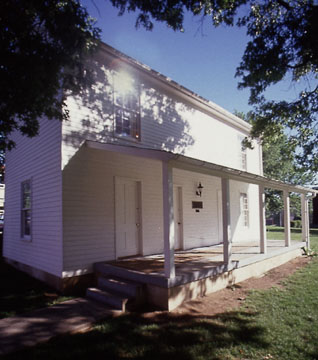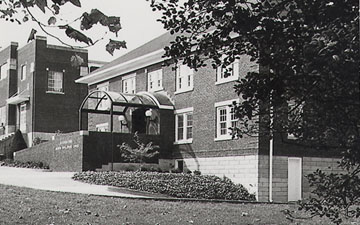History: 1980-1989
1980
In April work was completed on a major restoration of Bernard Chapel in Morrison Hall. The project was the gift of Raymond and Margaretta Bennett, who also donated a small prayer room adjoining the auditorium. The room was renamed Bennett-Bernard Auditorium.
The Classical Bulletin began publication at Asbury with Michael Harstad as editor.
A faculty committee prepared a revision of the faculty constitution and submitted this to the board through the president.
New townhouses for faculty and staff rental were completed.
On June 2 Roger Kusche resigned as dean and was replaced by William Coker.
In the fall the titles of the dean of student affairs changed to “dean of student development,” and the deans of men and women became “associate deans of students.”
In November Ronald Reagan, Republican, was elected President.
1981
Asbury formally resigned from the Council of Social Work Accreditation. Several campus officials feared that the CSWE interpretation of lifestyle diversity issues would compromise the college’s moral standards. By voluntarily resigning from the CSWE, Asbury forfeited accredited status for future graduates of its social work program. This proved to be a liability in obtaining employment in several states for graduates of the program.
On March 31 Dennis Kinlaw resigned as president, effective Aug. 31. He made the announcement in chapel on the same day.
Zachary T. Johnson died May 30. During funeral services in Hughes on June 2 Kinlaw declared that when he compared his own administration to Johnson’s long term in office, he felt like a “dwarf on the shoulders of a giant.” Kinlaw mentioned the College’s debt-free policy as a lasting legacy of Johnson’s long administration.

The original Asbury College building was moved to its present location on campus.
In August a special meeting of the board of trustees named C.R. Hager, now retired from the university, to serve as president until the Board could select a successor. Kinlaw was named “Ambassador at Large” for 1981-1982.
In the fall the Asbury College Archives were officially established, to be housed in the library.
The first campus broadcast studio was set up, using black-and-white equipment purchased from Centre College in Danville.
Ronald W. Holz replaced James Curnow as bandmaster of the Salvation Army Student Fellowship Band.
Also in this year IBM introduced the PC, the first personal computer. It used an Intel 8088 microprocessor and MS-DOS.
1982
In January James Anderson became chief of the Wilmore Volunteer Fire Department.
In March the chair of the Board President Search Committee reported that the committee could not agree upon a candidate and had no report. C.R. Hager agreed to remain as president until Aug. 1983.
However, on July 23 a special meeting of the Board at a motel in Lexington elected John N. Oswalt as president-elect, starting on Jan. 1, 1983, to become president in July. Oswalt, who like several recent predecessors lacked administrative experience, wisely asked for this transition period so he could learn the operation from Hager.
The first phonathon was held. It netted $9,690.
On Nov. 18, the College faculty held a banquet for Kinlaw, at which he was presented with the published results of a Festschrift held in his honor, entitled Spectrum of Thought.
The long decline in enrollment continued.
On Dec. 26 Mary Asbury Hughes Wilson died, aged 84. Born on campus in 1898, she was the last living connection to the College Founder, John Wesley Hughes.
1983
John Oswalt began as president-elect. A successful and respected author and speaker, Oswalt was faced with difficulties almost at once. The long decline in enrollment, for which he was not responsible, had a restrictive effect on resources, hence on program and personnel.
On Feb. 15 Mary Hughes was memorialized in chapel.
On May 17 the faculty and community held a banquet to honor Dr. C.R. Hager, whom many regarded as having saved the College twice. Wilmore Mayor Harold Rainwater declared this date “C.R. Hager Day.”
In July the student affairs department was renamed “student development.” Robert I. Imhoff was appointed dean of student development. Louis Caister became vice president and academic dean. Work began on a major renovation of Fletcher Hall, to convert it from a residence hall into an office building for student development staff.
In October the new, purpose-built Salvation Army Student Center was opened by General Jarl Wahlstrom.
Later in October John Oswalt was installed as president during a week of formal ceremonies.
1984
Faith and Philosophy: The Journal of the Society of Christian Philosophers was launched, with Michael Peterson as managing editor.

At commencement the newly rebuilt Fletcher Early Student Development building was dedicated. The building was named for John Fletcher, an associate of John Wesley’s, and for a patron, John L. Early of Sarasota.
Asbury Broadcast Communications students assisted in televising parts of the Summer Olympics in Los Angeles.
On Aug. 1, Edwin Blue became dean of student development.

In the fall two new positions were created: dean of admissions and enrollment (Jonah Mitchell) and spiritual life coordinator (Robert Moore). Charlie Fiskeaux became director of business affairs and treasurer.
In October after several years, in which the document was revised in unimportant ways dealing with tone, the board approved the first faculty constitution.
In November Ronald Reagan was re-elected as President of the U.S.
1985
During Feb. 23-28 the first “Black Recognition Week,” was held on campus. It was organized by an ad-hoc committee chaired by Bill Abernathy and Lt. Colonel Mel Bowdan.
In April, William Goold became vice president for institutional advancement. Upon Oswalt’s recommendation new titles were approved for the academic dean (now vice president for academic affairs and dean), the business manager (vice president for business affairs and treasurer) the director of development (vice president for institutional advancement) and student development (vice president for student development), effective June 1.
Harold Spann resigned as director of development, also effective June 1.
In the fall Asbury signed a formal affiliation with Case Western School of Nursing for a joint program in nursing.
The Board recommended the creation of an ad-hoc committee made up of members of both the College and seminary boards, which would study and propose the establishment of closer working ties between the two holiness institutions in Wilmore.
1986
In January Oswalt’s resignation was announced to the Board and faculty, effective Aug. 31, 1986.
Also in January a group of students and faculty from Jeloy Folk High school in Norway visited campus, as part of an annual exchange program.
In March the Board elected Dennis Kinlaw as president. On Kinlaw’s recommendation William Coker was named vice president of academic affairs and dean.
Several academic programs were dropped, including English as a second language, classical languages and the political science minor. The spiritual life coordinator position was discontinued.
The Cecil Zweifel Athletic Field was dedicated on June 1.
Construction began to connect the three wings of Johnson Hall into a single building. The same was done for Trustees Main Hall and Trustees Hall East Wing. The cafeteria was renovated and an elevator installed.
Enrollment continued to decline.
Jonah Mitchell began the “Asbury Ambassador” program.
President Kinlaw and Dean Coker took office Sept. 1. George Luce formally installed Kinlaw as president in chapel on Oct. 28. Jonah Mitchel resigned later in the fall.
1987
The fifth annual phonathon netted $137,261.
In February the Harry Hosier Scholarship was established for black students.
The journalism major was started.
Stanley F. Wiggam became dean of admissions in March.
In April Kinlaw reported to the board the lowest enrollment in 21 years.
During the fiscal year 1986-1987 the college endowment passed $10,000,0000.
In the fall the ten-year College Self-Study began. This process was the essential condition of SACSCOC reaccreditation.
In December Annette Fisher became Director of Counseling.
1988
Kinlaw was notably successful in integrating high academic standards with the College’s strong commitment to holiness, evangelism and missions. But he did not confine himself to theoretical matters alone. He now drew attention to the lack of American minority students on campus. In the spring he reported to the Board that in the past Asbury’s success at recruiting minorities had been “miniscule.” “Radical changes” were taking place in the American population, including the population of the Christian Church. “Our student body, faculty and staff must reflect the complexion of the community we desire to serve.” He planned a concentrated effort to recruit blacks.
In April Professor. Paul Vincent was appointed to chair the Centennial Celebration Committee to prepare for College’s 100 Anniversary, coming in two years. The board of trustees approved “in principle” a semester calendar.
Lt. Col. Melvan Bowdan became assistant to the president and director of multicultural student development. He was the first black to hold administrative rank at the College.
A faculty “Strategic Planning Committee” began operation in the fall.
Dr. Bonnie Banker was named vice president of academic affairs and dean—the first woman to occupy that position at Asbury.
On Sept. 19 General Eva Burrows spoke in chapel, the second of the Army’s international commanders to speak on campus within five years.
On Oct. 7 as part of the College’s centennial celebration, an official marker provided by the Kentucky Historical Society was placed on campus.
In the same month Kinlaw recommended the appointment of an ad-hoc committee made up of members of the Boards of both institutions, to study closer cooperation between the College and Seminary.
In November George H. W. Bush, Republican, was elected President.
Construction began on a major renovation of Hughes Auditorium and Morrison Hall. The two buildings were to be joined by a new building that provided additional offices and classrooms. The new portion was named in honor of the donors, brothers Walter and Clarence Reasoner.
Broadcast Communications students worked at the Winter Olympics in Calgary, Canada.
1989
Kinlaw reported to the board in March that recruitment of ethnic minorities relied heavily upon the Salvation Army, which so far was Asbury’s best hope for attracting black students to campus.
The self-study and reaccredidation process were successfully completed. The recommendations and suggestions, while wide-ranging, centered on matters of assessment, improved communications and professional credentialing.
In June the Board elected Ed Blue as executive vice president. Officially he was described as “Chief Operating Officer under the President, who will serve as Chief Executive Officer.” This arrangement, reminiscent of that between Johnson and Morrison fifty years earlier, was intended to release Kinlaw for more extensive speaking and fund-raising activities away from campus.
On Sept. 19 a large portion of the plaster ceiling in Hughes Auditorium fell onto the seats below. Chapel services were moved to the nearby United Methodist Church.
During restoration of the ceiling in Hughes Auditorium, air-conditioning was installed.
In the fall Professor Roy Lauter held an “old-fashioned camp meeting” on the campus green, to launch the centennial year.
With students from 46 states and seventeen countries, Asbury was the most cosmopolitan college in Kentucky.
The board approved a change from quarter terms to semester terms, effective fall 1991.
The theme of the Freshman Talent Show was “At the Movies.”